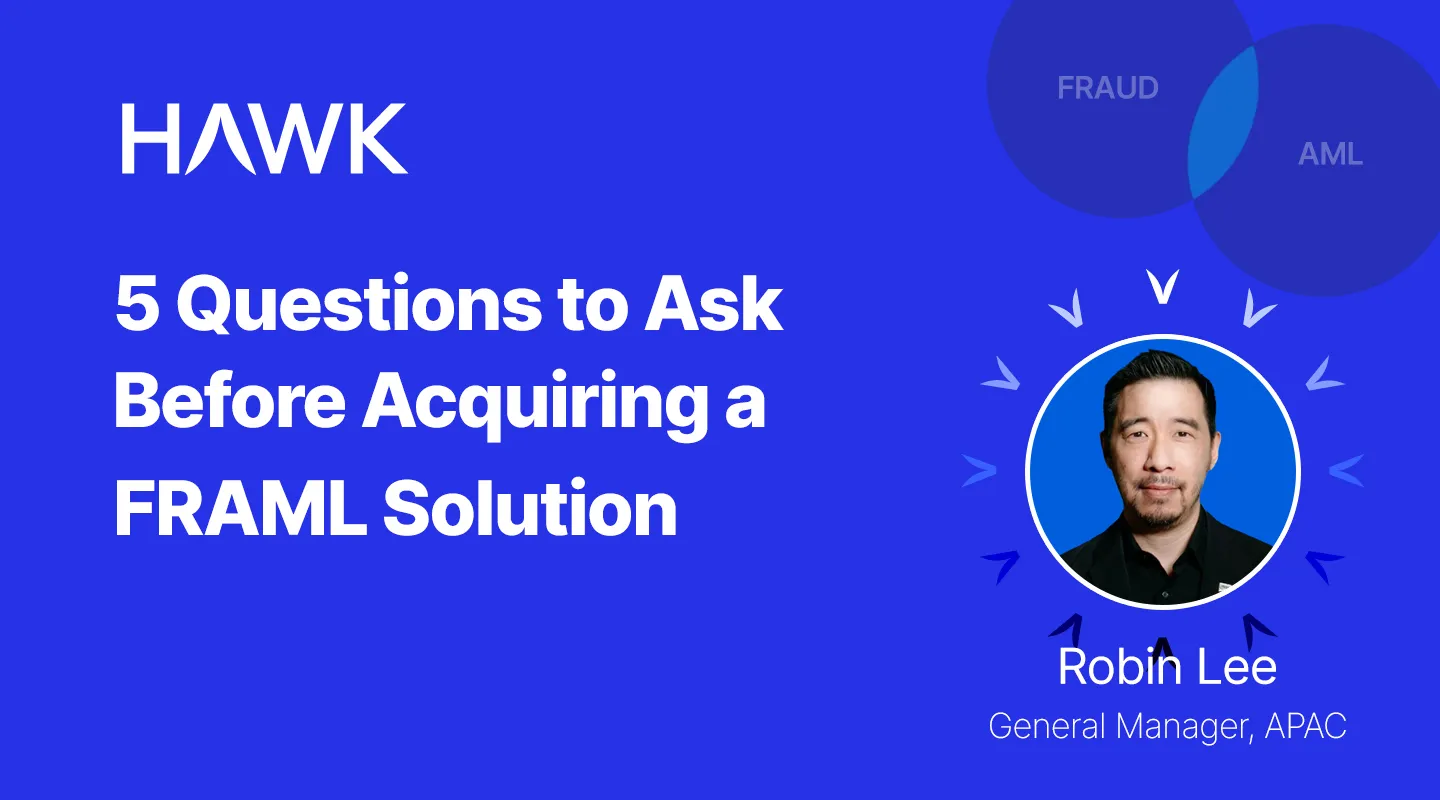5 Questions to Ask Before Acquiring a FRAML Solution

The threats posed to Financial Institutions (FIs) by fraud and money laundering proliferate—and get more sophisticated—by the day. Acquiring a Fraud Prevention and Anti-Money Laundering (FRAML) solution is a critical step for FIs aiming to safeguard their operations.
“We have seen a mass increase in fraud, and the proceeds get laundered into the financial system,” said Robin Lee, General Manager, APAC at Hawk AI. “The need to have a system which accommodates for both has become more and more prevalent.”
Selecting the right FRAML solution is not a one-size-fits-all process. In this article, we'll cover five essential questions to ask to determine whether a particular FRAML solution is a good fit for your FI.
Key FRAML Questions
Who Is Creating the FRAML Solution?
Can the FRAML System Accommodate Different User Types?
Is the System Truly a FRAML Solution?
How Much Control Do I Have over the FRAML Solution?
Does the FRAML Solution Have Appropriate Governance in Place?
1. Who Is Creating the FRAML Solution?
When vetting a FRAML solution, it’s important to determine who is building the product, who is doing the coding, and who is writing the AI algorithms. Building technology for Fraud Prevention and AML requires subject matter expertise in those fields, not technological know-how alone. Make sure your FRAML vendor understands your world and has built their solution accordingly. Without this marriage of financial crime and technical expertise, the result is often a “Frankenstein” product, featuring disparate code or algorithms that have been mashed together. This can lead to stability issues, integration errors, and explainability challenges.
“It's like putting an album together,” said Lee. “If the first song sounds like Britney Spears, the second track sounds like Tchaikovsky and the third sounds like Tupac, it's a challenging experience. It's the same thing with Frankenstein products.”
2. Can the FRAML System Accommodate Different User Types?
The mindset, education, and skills of a fraud officer are different from those of an AML officer, so the technology will need to function differently for each. While Fraud and AML officers will work with the same data, they have different workflows. Anyone considering a FRAML system will need to ensure that it appropriately accommodates both functions.
“I view it like finance and accounting,” said Lee. “Finance is looking to the future, and accounting is looking to the past. And with fraud, we are trying to predict the future. We're trying to stop a fraud before it happens. Whereas with AML, we’re looking at something that's already happened.”
3. Is the System Truly a FRAML Solution?
Shoehorning an existing AML solution into a fraud system—and vice versa—does not make for a true FRAML solution. This can also lead to stability issues, integration errors, and explainability challenges. However, the significant failing here is that the data is not sitting in the same place. You can make rectification attempts with data integrations and mapping, but it requires effort and even extra cost. When evaluating a FRAML solution, make sure that it was built for both Fraud and AML, not one or the other.
“On the system level, I think it's really interesting when it's integrated, because then you have the data sitting in the same place,” said Lee. “You can draw better insights from that or run more thorough investigations based on that as well.”
4. How Configurable is the FRAML Solution?
AML and Fraud Prevention professionals face the challenge of responding to an increasingly dynamic financial crime environment. Adapting to these rapid changes requires system flexibility and simplicity. Inability to change transaction monitoring rules, unconfigurable case managers and/or multiple case managers, and exorbitant professional services fees for making changes can hamper even the best investigators. The solution to these headaches is to use a FRAML system that users can configure without a high level of technical expertise.
5. Does the FRAML Solution Have Appropriate Governance in Place?
Quality governance is essential for ensuring that a FRAML solution is effective, compliant, and capable of managing the complex risks associated with fraud and money laundering. The following are governance controls any FRAML solution should include:
Policies & Procedures: the FRAML solution should have clear, documented policies and procedures for development, deployment, and ongoing management.
Risk Management Framework: the FRAML solutions should employ a robust risk management framework that identifies, assesses, and mitigates risks associated with monitoring for fraud and money laundering.
Regulatory Compliance: the FRAML solution must comply with relevant regulatory requirements and guidelines.
Data Governance: the FRAML solution should employ strong data governance practices, including data quality management, data privacy, and security measures.
Hawk AI’s FRAML Solution
At Hawk AI, our FRAML platform and applications are written from the ground up by individuals with subject matter expertise. Our platform accommodates fraud and AML users and was designed for both functions. Hawk AI’s FRAML solution is highly configurable and features robust governance controls. Our technology helps financial institutions across the globe achieve operational efficiency and regulatory compliance goals.
To learn more, read our FRAML white paper and request a demo today.